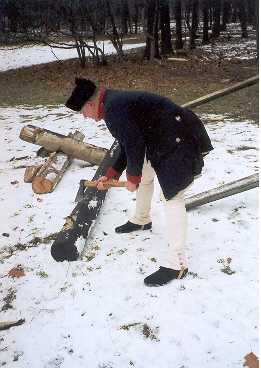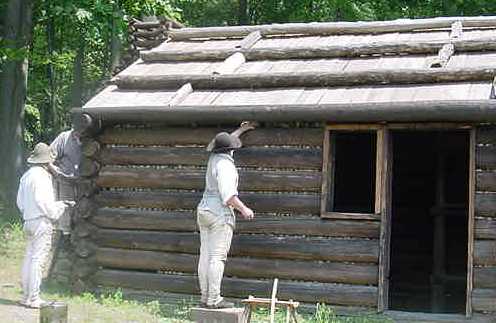Revision
Date: 11/13/2003
Intro:
Project Goals & Objectives, Overview
of Work, Advancing
into the Past, Tools
of the Trade,
Participating
Soldier Hut Rehabilitation:
Advancing into the Past with Living History
When the hut reconstructions were made in 1964-6, construction
problems were generally resolved with 1960s answers. However, often the
results are dependent on the means. The huts finished in 1966 gave
the general flavor, but upon examination show the 1960s technology more
than the historic technology. So, as the repairs are carried out
today, we ask not "How can we do this?" but "How did they do this in 1779?"
The answers require combining research with what some call "experimental
archaeology".
There have been three main benefits to using this
approach where possible and practical:
a. Builds relationships with scholars, re-enactment units and new volunteers.
b. Provides visitors, as well as staff, a better understanding of encampment
activities in 1779-80.
c. Insight from recreating original methods produces improved representations
of the original huts .

William Chemerka shows how replacement handles could
be made in Camp.
Volunteers have turned out to assist on many weekends. It seems
that every person who participates has something to contribute; an idea,
or an insight, and also gains new insights and experiences. Two Workshops
weekends were held in March 2003 where members of the 2nd NJ Regiment and
The German Regiment got hands on learning while recreating many aspects
of winter camplife. (See Volunteering for
more information on assisting in the project's living history program)
Roofing


Matthew Murphy notches to the mark made with the
compass.(Left) Mathew Grubel checks the fit upon installation.(Right).
photos
by Scott Shepherd


Members of The German Regiment, along with Park volunteers
installing the weight poles and fitting the shingles to make a "comb" at
the peak of a hut.


Living history does not stop with the hut work, but includes
as many aspects of camp life as possible. A breakfast of Hasty
Pudding (right) - a meal Joseph Plumb Martin recalled as being his primary
sustanance when on outpost duty during the 1779-80 winter. Dinner
was the same as breakfast but reheated on a shovel turned fry pan. photos
courtesy of The German Regiment
Chinking


Replacing the chinking.the authentic way. The use
of stones to fill the spaces and provide a material for the daub to adhere
to is a practice that has been documented in some early log cabins in Ohio;
and was likely a technique used by the soldiers at Morristown.
Sections of the interior walls were daubed with mud as an experiment.
The exterior and most of the interior is a mix of soil and cement that
is being developed as part of the project. The objective is to provide
the color and appearence of daub while minimizing the maintanence.
NPS
photos
Building Walls


New logs were hewn and notched to replace the rotted
ones and then the remaining old logs were reinstalled. As the crews developed
experience, they became quite skilled in using pivot points and leverage
to balance and maneuver the logs. However, many of the log joints in 1964-5
had multiple steel spikes through them. This created a number of additional
challenges (photo on right).
photos courtesy of Susan Data-Samtak
For more progress pictures of this hut being rebuilt see Participating
Hewing


Removing large chips with "narrow" axes is the first
step in squaring a log. The log is then scored in a similar manner to the
final depth. The remaining wood is the hewn with a broad axe. A smooth
finish can be made with an adze (not shown) if the surface can be turned
horizontal. One of the questions that has come up is whether the door and
window jambs were hewn, or did the army use some of the boards they had
purchased. One jamb was cut out with an alaskan chainsaw (as Mr. Leddel's
saw mill has been out of operation for 100+ years) and then finished by
hewing. The other jamb was split and hewn entirely by hand. This seemed
to be a very slow and difficult method, as hewing works well for heavy
square timbers, but was found to be very wasteful and tedious for those
of rectangular cross section. photo courtesy of Susan Data-Samtak
Back to:
Project Goals
& Objectives (intro)
Overview of
Initial Work (page 1)
Advancing into the Past (page 2)
Tools of the Trade (page 3)
Participating at the Pennsylvania Line (page 4)
More info Contact :
Mathew Grubel
Morristown National Historical Park (973) 539-2016
Note: The project is on indefinate hold as of Dec. 2003
You are still welcome to contact me via direct e-mail
here.













